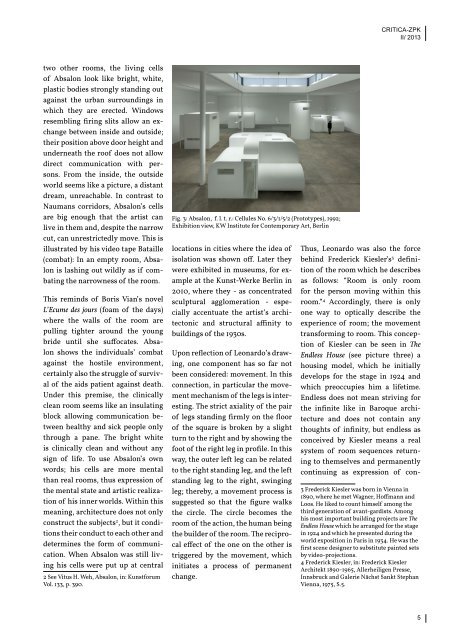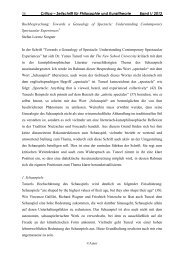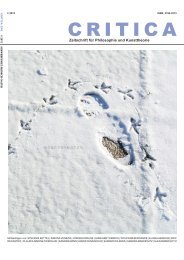Band II/ 2013 (7mb) - critica – zeitschrift für philosophie & kunsttheorie
Band II/ 2013 (7mb) - critica – zeitschrift für philosophie & kunsttheorie
Band II/ 2013 (7mb) - critica – zeitschrift für philosophie & kunsttheorie
Sie wollen auch ein ePaper? Erhöhen Sie die Reichweite Ihrer Titel.
YUMPU macht aus Druck-PDFs automatisch weboptimierte ePaper, die Google liebt.
CRITICA-ZPK<br />
<strong>II</strong>/ <strong>2013</strong><br />
two other rooms, the living cells<br />
of Absalon look like bright, white,<br />
plastic bodies strongly standing out<br />
against the urban surroundings in<br />
which they are erected. Windows<br />
resembling firing slits allow an exchange<br />
between inside and outside;<br />
their position above door height and<br />
underneath the roof does not allow<br />
direct communication with persons.<br />
From the inside, the outside<br />
world seems like a picture, a distant<br />
dream, unreachable. In contrast to<br />
Naumans corridors, Absalon’s cells<br />
are big enough that the artist can<br />
live in them and, despite the narrow<br />
cut, can unrestrictedly move. This is<br />
illustrated by his video tape Bataille<br />
(combat): In an empty room, Absalon<br />
is lashing out wildly as if combating<br />
the narrowness of the room.<br />
This reminds of Boris Vian’s novel<br />
L’Ecume des jours (foam of the days)<br />
where the walls of the room are<br />
pulling tighter around the young<br />
bride until she suffocates. Absalon<br />
shows the individuals’ combat<br />
against the hostile environment,<br />
certainly also the struggle of survival<br />
of the aids patient against death.<br />
Under this premise, the clinically<br />
clean room seems like an insulating<br />
block allowing communication between<br />
healthy and sick people only<br />
through a pane. The bright white<br />
is clinically clean and without any<br />
sign of life. To use Absalon’s own<br />
words; his cells are more mental<br />
than real rooms, thus expression of<br />
the mental state and artistic realization<br />
of his inner worlds. Within this<br />
meaning, architecture does not only<br />
construct the subjects 2 , but it conditions<br />
their conduct to each other and<br />
determines the form of communication.<br />
When Absalon was still living<br />
his cells were put up at central<br />
2 See Vitus H. Weh, Absalon, in: Kunstforum<br />
Vol. 133, p. 390.<br />
Fig. 3: Absalon, f. l. t. r.: Cellules No. 6/3/1/5/2 (Prototypes), 1992;<br />
Exhibition view, KW Institute for Contemporary Art, Berlin<br />
locations in cities where the idea of<br />
isolation was shown off. Later they<br />
were exhibited in museums, for example<br />
at the Kunst-Werke Berlin in<br />
2010, where they - as concentrated<br />
sculptural agglomeration - especially<br />
accentuate the artist’s architectonic<br />
and structural affinity to<br />
buildings of the 1930s.<br />
Upon reflection of Leonardo’s drawing,<br />
one component has so far not<br />
been considered: movement. In this<br />
connection, in particular the movement<br />
mechanism of the legs is interesting.<br />
The strict axiality of the pair<br />
of legs standing firmly on the floor<br />
of the square is broken by a slight<br />
turn to the right and by showing the<br />
foot of the right leg in profile. In this<br />
way, the outer left leg can be related<br />
to the right standing leg, and the left<br />
standing leg to the right, swinging<br />
leg; thereby, a movement process is<br />
suggested so that the figure walks<br />
the circle. The circle becomes the<br />
room of the action, the human being<br />
the builder of the room. The reciprocal<br />
effect of the one on the other is<br />
triggered by the movement, which<br />
initiates a process of permanent<br />
change.<br />
Thus, Leonardo was also the force<br />
behind Frederick Kiesler’s 3 definition<br />
of the room which he describes<br />
as follows: “Room is only room<br />
for the person moving within this<br />
room.” 4 Accordingly, there is only<br />
one way to optically describe the<br />
experience of room; the movement<br />
transforming to room. This conception<br />
of Kiesler can be seen in The<br />
Endless House (see picture three) a<br />
housing model, which he initially<br />
develops for the stage in 1924 and<br />
which preoccupies him a lifetime.<br />
Endless does not mean striving for<br />
the infinite like in Baroque architecture<br />
and does not contain any<br />
thoughts of infinity, but endless as<br />
conceived by Kiesler means a real<br />
system of room sequences returning<br />
to themselves and permanently<br />
continuing as expression of con-<br />
3 Frederick Kiesler was born in Vienna in<br />
1890, where he met Wagner, Hoffmann and<br />
Loos. He liked to count himself among the<br />
third generation of avant-gardists. Among<br />
his most important building projects are The<br />
Endless House which he arranged for the stage<br />
in 1924 and which he presented during the<br />
world exposition in Paris in 1934. He was the<br />
first scene designer to substitute painted sets<br />
by video-projections.<br />
4 Frederick Kiesler, in: Frederick Kiesler<br />
Architekt 1890-1965, Allerheiligen Presse,<br />
Innsbruck and Galerie Nächst Sankt Stephan<br />
Vienna, 1975, S.5.<br />
5




